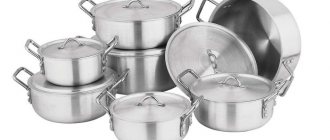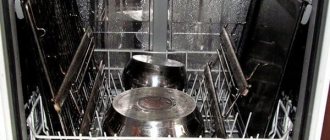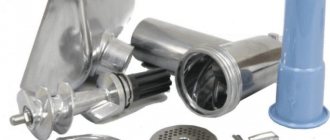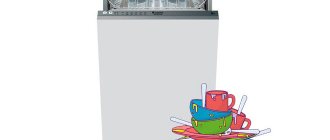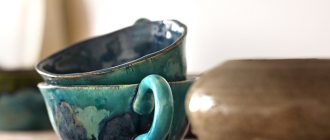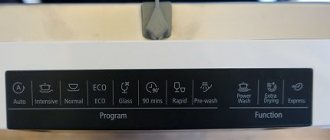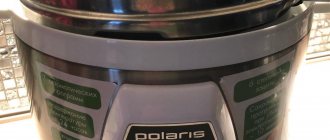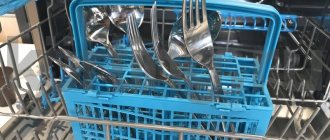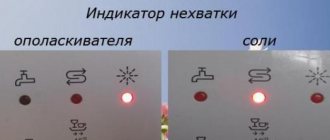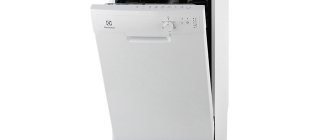Have you ever wondered whether pots can be washed in the dishwasher? It all depends on the dimensions and materials of the dishes, on the parameters of the PMM.
Do not place, for example, aluminum or wooden utensils in the dishwasher. What is the situation with pans - stainless steel, ceramic and Teflon coated? If you want to know the details, read our article.
How to properly wash a pan in a PMM?
- Before loading into the dishwasher, remove any leftover food and rinse under running hot water.
- Make sure it is made from a material that can be washed in a detergent.
- Place it on the lower basket. Installation method: upside down. It is important that large dishes do not interfere with the operation of the dishwasher.
- Use intensive mode.
How to wash cast iron kitchen utensils correctly
Is it possible to wash a cast-iron frying pan in the dishwasher? We found out, now we’ll figure out how to properly clean cast-iron cookware after cooking. Such utensils must be washed extremely carefully, but thoroughly, with a sponge without a hard abrasive layer, under warm water with a drop of gentle detergent without alkali. You cannot rinse such dishes with hot water, and especially boiling water.
The bottom of cast iron cookware should always remain slightly oily, so before storing the product until the next cooking, wipe the bottom with a drop of vegetable oil.
Usually, nothing burns or sticks to the bottom of cast-iron utensils, but if this happens, then you need to pour water into the dishes to the level of the burnt food and put it on the fire until it boils. As soon as the liquid has cooled to room temperature, you can wash the cast iron with a sponge without effort or problems. After washing, be sure to dry.
The bottom of such dishes should always remain slightly oily, so before storing the product until the next cooking, you need to wipe the bottom with a drop of vegetable oil. Thus, cast iron cookware will retain its non-stick properties and last for many years.
What can be loaded into the PMM?
If a dishwasher only washed plates and cups, she would be worthless. Housewives need more serious help - they need to wash pots and pans. But before loading dirty dishes into the PMM chamber, you need to find out what they are made of. Not every material is suitable for water procedures in the dishwasher hopper. What you need to know about materials and coatings:
- Products with ceramic coating can be loaded into the chamber. Both a full cycle and an express mode are suitable for them.
- Titanium coating. Such dishes are washed with gentle means, setting a low temperature.
- Stainless steel. Stainless steel cookware has a thin non-stick layer - due to powerful processing, it will gradually wear out and food will stick to the surface.
- Aluminum. It is allowed to load aluminum products only if they have a durable coating, otherwise they will darken.
- Glass. They are allowed to wash in the PMM, but with the condition - not to hit neighboring objects.
- Gilded drawing. Processes in the dishwasher will cause the drawings to fade and then be completely erased.
Limitations for cookware
There are situations when such equipment is not able to cope with the assigned tasks. You need to understand that not all dishes can be sent to such a machine. This rule applies to fragile products. It is better to wash dishes made of earthenware or crystal by hand so as not to destroy the design or surface. In addition, the unusual color of the product may disappear. Experts advise not to skimp on the choice of such devices, which allows you to cope with any contamination of the dishes. Most often you have to deal with the difficulty of washing pots.
Not many people understand whether they can be put in the dishwasher or not. Additional modes are used to wash such products. Pots must be placed in a special basket. You need to understand that household appliances have two baskets. One of which is intended for light weight cookware, the other is suitable for pots and pans. There may also be a tray that is dedicated to cutlery.
Important! The more compartments for dishes, the more expensive the dishwasher will cost. This must be taken into account when choosing a model of household appliances.
How is washing done?
Knowing how a dishwasher works, it is easier to understand what items can be washed in it. Process steps:
- Start the program. Water begins to flow into the chamber - cold or hot.
- Maximum water heating is 70 °C.
- The detergent comes from the dispenser - powder, gel or soluble tablet.
- Water collected in the tank enters the sprinklers, which, rotating, wash objects.
- Water circulation continues for the time specified by the program.
- When the main process is over, the dirty water goes into the sewer. Clean water enters the tank and rinsing begins.
- Recent PMMs provide gentle cycles that operate at low water temperatures - they are used for lightly soiled dishes.
It is clear that with this approach, it will not be possible to wash off severe stains - old, with soot - even in a few hours. It is unlikely that you can wash a dirty pan in which stew or porridge has burnt in the dishwasher - you need to work with a mesh or brush using abrasive chemicals.
Restrictions on other cookware
But thin plastic, cut-out wood kitchen utensils and aluminum do not limit the limitations of automatic washing. What other types of dishes should not go into the dishwasher? Machine models with a limited set of programs require special attention in relation to:
- Things made of fine porcelain. Although any porcelain has no place in the dishwasher, delicate ones will be especially sad when they crack from hot water. And the included turbo dryer will become a funeral requiem for him.
- Cast iron frying pans, casserole dishes and other ferrous metal products. Of course, an automatic wash alone won’t be able to finish them off, especially large items. But the second or third attempt will definitely lead to corrosion spots. And it will immediately become clear why it is better to wash such heavy objects by hand.
- Crystal and souvenirs. Their fragile beauty was not created for automatic car washes, so the fateful date may not be tolerated. Crystal has a bad habit of cracking due to temperature changes. Or in the process it will become covered with micro-scratches and come out completely damaged.
- Vessels with vacuum lids. Such food containers, saucepans and mugs with lids that can pump out air so that a vacuum is formed inside to preserve food, should not end up in the dishwasher, even by accident. In an automatic machine they undergo a certain deformation. It may be invisible to the naked eye, but the seal is lost and air begins to leak under the covers.
- Sharpened kitchen knives. The general rule for caring for such items is that knives are quickly rinsed with cool water under running water. Then they don't become dull. Hot water affects the sharpness, and 5-7 minutes is enough for this. With constant contact with hot water, knives will have to be sharpened every other day, which will very quickly lead to abrasion of the blades. It is clear that prolonged rinsing in hot water in the dishwasher is contraindicated for a sharp knife. And the same applies to scissors and other sharp objects that you want to wash automatically.
- Copper products also do not like high water temperatures. And upon contact with harsh detergents, they will simply turn green, oxidizing and losing their former appearance.
- Thermoses and thermal mugs. Usually they are washed only by hand. An exception may be thermal containers, which the manufacturers themselves declare as being able to withstand automated washing without damaging the heat-insulating layers. Still, it’s better not to risk that the temperature of your favorite drinks will not remain as long as before.
In reality, this list can easily be expanded to include dishes with drawings printed on them, souvenir cups and mugs with photo printing, and other representatives of the tableware tribe, which can easily lose their colorfulness. If you know how dishwashing equipment works, you can avoid such mistakes.
Dishwasher characteristics
The ability to wash the pan depends on:
- Dimensions of the device. Large dishes may not fit in the dishwasher hopper. If you have a compact model, you can only wash a 2-liter container. You won’t be able to fit saucepans that are too bulky into the narrow model either. If you want to wash large utensils, buy a full-size PMM.
- Functionality. If your machine does not have an intensive wash mode, then washing dirty pots is like light rain. It is advisable that the programs include soaking - with it the washing process will be more successful. Perhaps your model has a special program for pots. To find out, read the instructions.
- Washing class. Dishwashers are graded according to their washing class. Today you won’t see C- and D-class devices. Only class A and B equipment are available for sale. Class A machines are capable of washing the most difficult stains, plaque and congealed grease.
- Drying systems. Condensation drying is more common. How does it work? The products are heated and moisture is removed from their surface. This is an economical method but takes a long time. There are fewer models with turbo drying on sale. It allows you to dry plates faster, as air is used. This process requires energy. This is a less economical option. Users of PMMs with condensation drying often complain that moisture remains on the dried dishes.
Stop list for dishwashers
Regardless of the material, it is prohibited to wash dishes or any items with stickers in the dishwasher. These pieces of paper will definitely “peel off” from the surface being cleaned and end up in the filters.
The consequences are predictable - the PMM will most likely break immediately. It’s good if the automatic safety system works, otherwise you’ll have to call a specialist to repair the equipment or send it for service.
Aluminum and silver products
Hot water in PMM aluminum and silver is not dangerous. However, the household chemicals used for washing are extremely harmful to them. After being in the dishwasher, utensils made from these metals begin to darken and become coated.
When exposed to water for a long time, aluminum releases ions. If you put a lot of aluminum cookware in the dishwasher for two to three hours at the same time, then everything inside will be “painted” with a corresponding metallic coating.
Moreover, aluminum will not only cover the internal walls of the PMM, but can also clog the nozzles on the sprinklers. Breakdown and subsequent repair of the dishwasher in this case is inevitable.
A video with visual explanations of why you can’t wash aluminum kitchen utensils in a PMM:
Wooden and cast iron objects
Wood and water are not very compatible materials. It is better to wash wooden spatulas, cutting boards and rolling pins yourself. They in PMM will first swell from excess moisture, and then shrink under the influence of high-temperature air drying.
The result will be cracked utensils, unsuitable for further use for their intended purpose. Nowadays, many wooden cutting boards are made not from a single piece of wood, but from glued pieces. If such a prefabricated product is kept in water for a long time, it may fall apart into individual elements.
And even if it doesn’t fall apart, it will definitely come apart in the glued areas. In this case, the consequences are even worse - the glue from the board will subsequently enter the body with food.
Cast iron frying pans, cauldrons and kettles become covered with a thin film of fat over time. It protects this metal from water and oxygen, which prevents the formation of rust on such utensils.
With manual washing, greasy deposits are never completely washed away, but with automatic washing with a large amount of detergent, it disappears. And then the unprotected cast iron begins to rust.
Knives, strainers and garlic presses
Knives made of stainless steel become slightly dull after a long stay in the dishwasher. That is, the material itself is not afraid of PMM. However, the knife will have to be sharpened again after such a wash.
This also applies to graters and any other utensils with a sharp edge for cutting food. They can not only become dull, but also scratch the internal walls and mechanisms of the washing machine.
Strainers, graters, vegetable cutters and devices for cutting food into shapes will have to be washed by hand. They have a lot of small nicks and grooves, where particles of vegetables, fruits, meat, etc. remain after cooking. The jets sprayed by the nozzles in dishwashing equipment are not able to wash away such “crumbs”. They can only be cleaned manually.
It is also not recommended to put knives and other parts of the meat grinder in the dishwasher. On the one hand, the cutting edges will become dull, and on the other, the metal from which this machine is made will oxidize. Then you will have to clean the blackened surfaces with abrasive powders by hand.
Thermos and crystal products
Often thermoses are designed in such a way that the flask is wrapped in heat-insulating material. However, when wet, thermal insulation not only loses its properties, but also deteriorates. Plus the effect of chemicals from “soap” with unclear consequences. Even after complete drying, the insulation will not retain heat as well as before.
The thermos should be washed exclusively by hand. You cannot place it in water or steam for a long time. Moreover, it is not recommended to do this, even if it does not have a heat insulator.
There is always empty space between the outer casing and the bulb. If you do not disassemble it, the water that gets there will not dry completely. And the result is an unpleasant musty amber.
Some crystal items can be washed in the dishwasher. However, not all: there are many different types of crystal, and most of them are contraindicated at temperatures above +50 0 C. The consequences of such heating are microcracks inside the crystal glass. For crystal products, expensive PMMs have special programs.
It is allowed to place crystal dishes in cheap dishwashers only if this is permitted by the manufacturer of such dishes. The packaging of this product must clearly indicate “allowed.”
If you don’t have a box for a crystal vase at hand, then it’s not worth the risk. Crystal may crack or become dull and cloudy when heated. But it certainly won’t become more beautiful after washing it in a machine with specialized products.
What to wash with?
The products you used to manually wash kitchen utensils cannot be used in the dishwasher. The stores have special washing products for PMM. Release form: powder, gel or tablet. The latter is a compressed briquette, which, in addition to detergent, may contain salt, rinse aid, and other useful substances with different effects. Features of application:
- Powders, gels and simple tablets require the parallel use of salt and rinse aid.
- Universal tablets - "three in one" - do not need any additions. They contain everything you need for washing.
Choose products that contain enzymes. These substances, by breaking down organic compounds, remove complex contaminants and improve the quality of washing.
How to clean the multicooker bowl?
The main rule for washing a bowl is not to use metal or hard sponges or abrasive substances, and clean very carefully.
From burnt food
If food is burnt in the bowl, never clean it with abrasives or hard brushes.
To clean the container, fill it with warm water and add 1 cap of Sypha. Leave the bowl to soak for 1-2 hours, and then remove excess dirt with a sponge.
You can also avoid burning if you follow simple recommendations:
- set the mode temperature correctly, without exceeding the maximum set by the program;
- Wash the cup after each use;
- make sure that the valves are not clogged;
- Do not fill the container with more than the permitted volume.
From fat
Remove grease stains using dishwashing detergent. Wipe the interior and exterior of the multicooker with a soapy sponge and then rinse with water. At the last stage, wipe all elements of the device dry.
From burning
Usually carbon deposits form on the bottom of the multicooker under the bowl. To get rid of burning:
- Wipe the bottom with a damp cloth.
- Cover the surface with baking soda.
- Leave the substance for 15 minutes.
- Remove excess soda and carbon deposits with a damp soft cloth, so as not to scratch the coating.
- Wipe the bottom with a dry cloth.
From scale
If scale appears on the surface of the bowl, citric acid or vinegar will help.
It is important to start the fight at the first appearance of plaque, and not wait until the scale completely covers the bowl
Wipe the internal and external parts of the multicooker on which plaque has formed with a soda solution. Leave the mixture on the surface for 10–15 minutes and then wipe with a damp cloth.
From mold
If, after washing, the bowl and lid of the multicooker were not sufficiently dried, mold fungi may appear in areas of excess moisture. To remove dirt and disinfect the surface, use regular soda. For this:
- Fill the bowl with water to the maximum level.
- Dissolve a small amount of baking soda in water.
- Set the soup mode or any other program so that the water boils.
- Wait until the appliance has finished operating and rinse the bowl.
- Wipe all surfaces with a dry cloth.
